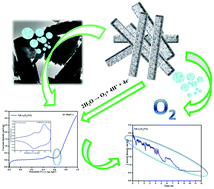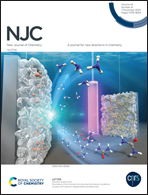Electrochemical water splitting exploration of MnCo2O4, NiCo2O4 cobaltites†
Abstract
One-step solvothermal synthesis is used to produce Mn and Ni based cobaltites. The cubic phases of MnCo2O4 and NiCo2O4 are confirmed using X-ray diffraction spectra (XRD). Scanning electron microscopy (SEM) and transmission electron microscopy (TEM) images, along with the crystalline orientations correlated to SAED patterns, reveal the fine nanoparticle morphology and typical nanorod morphology of Mn and Ni cobaltites. Electrochemical studies are used to test the electrochemical water oxidation capabilities of both cobaltites. Unlike MnCo2O4, which has a poor overpotential of 507 mV, NiCo2O4 nanorods synthesized via a controlled alkaline chemical atmosphere of pH-10 show high catalyzing ability to split water at a low overpotential of 364 mV. Activity from linear sweep voltammograms (LSV) shows similar superiority of the NiCo2O4 nanorods with a current density of 3.21 mA g−1 at 10 mV s−1 and a minimal Tafel slope value of 67 mV dec−1. The low overpotential of 364 mV is also maintained throughout the electrochemical water oxidation process, with a current density of around 0.6 mA g−1 after 12 h. The selected candidate could be explored as a brilliant electrode material for long-term and sustainable energy production applications in the near future.



 Please wait while we load your content...
Please wait while we load your content...